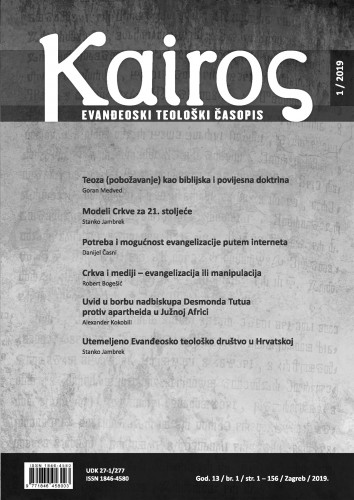Za plodonosno razumijevanje prirode Crkve Biblija koristi niz slika koje zajednički tvore modele Crkve prema kojima vjernici žive i djeluju. Modele Crkve razmotrili smo u tri kategorije: prvu čine modeli koje danas kreira svakodnevni život, drugu čine modeli koje su kroz povijest osmislili ljudi i, treću, modeli utemeljeni u Riječi Božjoj. Modeli Crkve, koje danas kreira svakodnevni život, i modeli Crkve, koje su kroz povijest osmislili ljudi, služe nam kao negativni primjeri modela koje treba mijenjati i izbjegavati, posebice modele Crkve kao institucije i kao denominacije. Biblija prikazuje specifičnu stvarnost i narav Crkve brojnim i različitim slikama iz svakodnevnog života. Među njima su slike iz sustava vlasništva; slika funkcioniranja ljudskoga tijela; slike predbračnog, bračnog i obiteljskog života; slike iz područja graditeljstva, poljodjelstva, stočarstva, ribarstva te građanstva i domoljublja. Svaka od upotrijebljenih slika komunicira jednu ili više Božjih istina na način koji je iskustveno vrlo blizak i poznat slušateljima i čitateljima. Te su slike odraz života i upućuju na život. Kršćanstvo 21. stoljeća treba usvojiti i primijeniti biblijske slike Crkve koje zajednički tvore biblijski model Crkve. Pri uspostavi modela trebamo se usredotočiti na Boga i njegove svrhe i planove za konkretno vrijeme, prostor i kulturu. Komunikacija s Bogom treba biti potpuno otvorena, a Crkva spremna slijediti Božje planove i vodstvo Svetoga Duha. Biblijski model Crkve sadrži Božje (nepromjenjive) i ljudske (promjenjive) elemente. Bog je nepromjenjiv, stoga je trajno i nepromjenjivo u Crkvi sve ono što dolazi od Boga, a mijenjati se može i mora sve ono što je došlo od ljudi. Ljudski elementi trebaju biti u skladu s Riječju Božjom i vodstvom Svetoga Duha kako bi Crkva plodonosno vršila Božju volju.; In order to have a fruitful understanding of the nature of the Church, the Bible uses a variety of pictures, which when taken together form Church models by which believers live and act by. We have reviewed Church models in three categories: the first category is taken by Church models which are formed today by our everyday life; the second one are Church models which have been created by man throughout history; and third, the Church models which have a foundation in the Word of God. Church models formed by everyday life and man-made Church models can be used as negative examples of models to be changed and avoided, especially models of the Church as an institution and as a denomination. The Bible shows a particular reality and nature of the Church by using numerous different pictures from everyday life. These include pictures from the ownership system; the picture of the way the human body works; pictures from premarital, marital, and family life; pictures from architecture, agriculture, cattle breeding, fishery, and citizenship and patriotism. Each of the used pictures communicates one or more God’s truths in a way that is experientially very close and familiar to the listeners and readers. These pictures reflect life and point towards life. The 21st century Christianity needs to adopt and apply Biblical pictures of Church which, when taken together, form the Biblical Church model. As we establish this model, we need to focus on God and His purposes and plans for a specific time, place, and culture. Our communication with God needs to be completely open, and the Church needs to be prepared to follow God’s plans and the guidance of the Holy Spirit. The Biblical Church model contains God’s (immutable) and human (mutable) elements. God is immutable, which is why anything that is permanent and immutable in Church comes from God, and what can and needs to be changed is anything that came from people.
Sažetak

 Kairos : evanđeoski teološki časopis 13,1(2019) / glavni i odgovorni urednik Stanko Jambrek.
Kairos : evanđeoski teološki časopis 13,1(2019) / glavni i odgovorni urednik Stanko Jambrek.